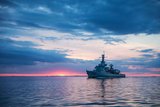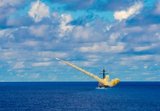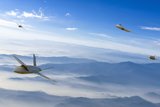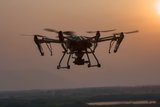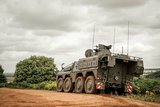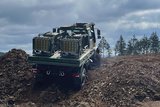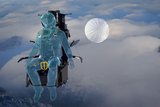How stabilizers work & the latest technologies (sponsored)
Since 1985, Quantum has invented and patented two main types of stabilizer systems: fins, and rotors. Unlike passive bilge keels, anti-roll tanks or fixed fins, these “active” stabilizer systems are driven by formulas or algorithms that control the movement of the fin or rotor underwater. The vessel motion or roll tends to be more extreme at zero or slow speeds than underway or higher speeds. Similarly, the power required to move the fin or rotor at zero/low speeds tends to be much greater as well. The Quantum system uses the specifications and requirements on a given vessel to develop a unique algorithm, with parameters (or limits) programmed into the controls that direct the movement of the fins or rotors. Some of the influential factors that are used to develop the algorithm are: the natural roll period, vessel speed, metacentric height (GM), gross tonnage (GT) and sea direction and wave significant height, etc. Additionally, a fast roll period is much more demanding on the system than a slower roll period.
What separates one stabilizer from another? The controls!
The proprietary controls are one of the major differentiators from one stabilizer brand to another. For Quantum, it starts with a roll sensor. Imagine that a wave suddenly hits your vessel, the roll sensor detects the wave and transmits the roll angle and roll velocity to the main controller for processing. Using the defined algorithms, the main controller sends the appropriate response to counteract the roll with the optimal fin or rotor movement and the necessary hydraulic pressure with little to no human input at all.

How do you minimize the drag with these appendages?
The fin shape, profile and aspect ratio can reduce the drag when properly optimized. With regular fins, it is vital to strategically set up the zero speed™ fin angles to be in line with the least resistance at cruising speed. This can be easily measured with differential pressure at any required speed. Retractable stabilizers, available on the MAGLift™ and Dyna-Foil™ can be fully retracted into a pocket or to the underside of the hull, to minimize drag when not in use.


How effective are stabilizers in reducing the roll?
Very. It is possible to remove up to 90% of roll, however the sea state plays into this directly. Larger sea states require greater fin area and hydraulic power. A vessel is most stable when trying to keep the ships average roll angle below a threshold which is in proportion to the vessels roll period. As an example, a vessel with a 10 second roll period has an average roll angle of 0.59º in a 1 meter sea.
Pioneering solutions through 3 International Patents:
XT™ Fins
The main stabilizer fin houses another fin or “foil,” designed to extend or retract based on the speed of the vessel. When the foil is extended for zero speed™ applications, it provides 30% more surface area, while generating 100% more lift force. To maximize the performance underway, the foil is retracted, reducing the surface area and the corresponding drag.
Video - XT Fin Video

MAGLift™ Rotor
Based on the “Magnus Effect,” a phenomenon where a rotating cylinder creates lift (stabilization) proportional to the speed and direction of the rotation. This phenomenon can be compared to the deflection of a spinning object moving through the air or fluid, such as a topspin tennis ball. It is perfect for slow/loitering and zero speed applications. The rotors are also completely retractable underway, making it ideal for ice class or high-speed vessels to where drag is a consideration.
Video - MAGLift Rotor Video

Dyna-Foil™
Dyna-Foil™ is the latest and most advanced technology on the market. The new design underwent extensive third-party model testing by MARIN (Marine Research Institute Netherlands). It represents the only system in the stabilizer industry, that is dedicated to Zero Speed™ and underway performance with retractable capabilities. It features a high aspect, articulating foil that maximizes roll reduction and comfort at all speeds. Dyna-Foil uses more lift, with less drag and less power, therefore more efficient and ideal for vessels with space limitations for a fixed fin to fit within the hull’s envelope and Ice Class applications.
1st Dyna-Foil™ System on 70m Benetti Refit - Video - Dyna-Foil Video

Study Correlating Age and Seasickness
A study conducted in 2018 by the MARIN, Maritime Research Institute Netherlands revealed some unexpected results on seasickness sensitivity and how it relates to age. It seems the younger ages are far more vulnerable to motion disturbances due to their “young” and more sensitive vestibular systems. Therefore, as age increases, the ability to receive sensory information about motion and balance declines. Of course, regardless of age, stabilizers greatly reduce and minimize the debilitating effects of seasickness.

For more information on Quantum and stabilizer solutions, contact the company directly via:
Quantum Marine
3685 SW 30th Ave
Ft. Lauderdale, FL 33312
USA
T: +1 (954) 587-4205
More from Industry Spotlights
-
![The future is here: Sixth-gen air dominance]()
The future is here: Sixth-gen air dominance
How RTX is equipping the military airspace – for today’s fleet and tomorrow’s fight.
-
![De-Risking the Future: Manufacturing Certainty for Unmanned Systems]()
De-Risking the Future: Manufacturing Certainty for Unmanned Systems
How strategic manufacturing partnership solves the industrialisation triad — Scale, Compliance and Cost — for hyper-growth defence tech innovators.
-
![Battlefield mobility, made in the UK]()
Battlefield mobility, made in the UK
How does Britain ensure that we can preserve the lives of our soldiers and allies – now and in the future – with homegrown innovation and resilient domestic manufacturing? At Pearson Engineering, we are proud to be a central part of the answer to this increasingly important question.
-
![Strengthening Baltic defence capabilities]()
Strengthening Baltic defence capabilities
How Latvia is bolstering its territorial defences, industrial capacity and international cooperation with Dynamit Nobel Defence’s SKORPION2 Remote Mining System.
-
![Barco’s vision to trust: from past to future]()
Barco’s vision to trust: from past to future
Barco’s story is one of constant evolution enabling more immersive, reliable, and future-ready training experiences.
-
![How are next-generation ejection seats helping pilots when they need it most?]()
How are next-generation ejection seats helping pilots when they need it most?
The ACES 5 ejection seat from RTX’s Collins Aerospace introduces new, innovative and patented technologies to help save lives.








